How Earthquakes Change The Earth's Surface And Atmosphere
The Forces that Change the Face of Earth
Despite our tendency to consider Earth equally static, it is actually a dynamic and ever-changing planet. Wind, water, and ice erode and shape the land. Volcanic activity and earthquakes modify the landscape in a dramatic and often fierce fashion. And on a much longer timescale, the movement of earth'south plates slowly reconfigures oceans and continents.
Each 1 of these processes plays a role in the Arctic and Antarctica. Nosotros'll hash out each in general and specifically in the polar regions.
EROSION
Air current, water, and ice are the iii agents of erosion, or the conveying away of rock, sediment, and soil. Erosion is distinguished from weathering — the concrete or chemical breakup of the minerals in rock. All the same, weathering and erosion can happen simultaneously. Erosion is a natural process, though information technology is frequently increased by humans' use of the land. Deforestation, overgrazing, construction, and road building oftentimes expose soil and sediments and pb to increased erosion. Excessive erosion leads to loss of soil, ecosystem impairment, and a buildup of sediments in h2o sources. Edifice terraces and planting copse can assistance reduce erosion.
GLACIERS
In the Chill and sub-Chill, glacial erosion has shaped much of the landscape. Glaciers primarily erode through plucking and abrasion. Plucking occurs as a glacier flows over boulder, softening and lifting blocks of stone that are brought into the ice. The intense force per unit area at the base of operations of the glacier causes some of the ice to melt, forming a thin layer of subglacial water. This water flows into cracks in the boulder. Equally the water refreezes, the ice acts as a lever loosening the stone by lifting information technology. The fractured rock is thus incorporated into the glacier'due south load and is carried along every bit the glacier slowly moves.
Abrasion happens when the glacier's ice and rock fragments act as sandpaper, burdensome the rock into finely grained rock flour and smoothing the stone below. Meltwater streams of many glaciers are grayish in color due to high amounts of rock flour.
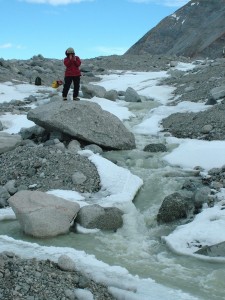
In a higher place-freezing temperatures created a meltwater stream on the Scott Glacier, Antarctica. Photo courtesy of BlueCanoe (Flickr).
Glacial erosion is evident through the U-shaped valleys and fjords that are located throughout the Chill and sub-Arctic regions. Glacial moraines are formed every bit a glacier recedes, leaving behind big piles of rock, gravel, and fifty-fifty boulders. Moraines may form at the human foot (last moraine) or sides (lateral moraine) of the glacier or in the heart of 2 merging glaciers (medial moraine).
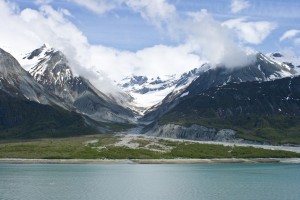
A U shaped Valley in Alaska.
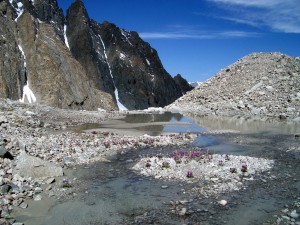
Glacial moraine in Kyrgyz republic.

A fjord in Norway.
Photos courtesy (T to B) of Skylar Primm, Geir Halvorsen, and Martin Talbot (Flickr).
Littoral erosion has become a major effect in contempo years in the Chill, with Alaska's Due north Slope losing as much as thirty meters (100 anxiety) per year! Climate change is thought to be the underlying crusade. As the climate warms and bounding main water ice melts, more of the dominicus's energy is absorbed past bounding main h2o. As this oestrus is transferred to the land, the permafrost (frozen soil) thaws, making the declension vulnerable to erosion from moving ridge activeness and storms (which are more frequent due to warmer temperatures and open h2o). This video from the University of Colorado Boulder and the U.S. Geological Survey shows time-lapse images during one month of crumbling.
WIND
In Antarctica, katabatic winds play a large office in erosion. This type of wind occurs when high-density common cold air builds up at high elevations (on the ice sheets, for case) and moves downhill under the force of gravity.
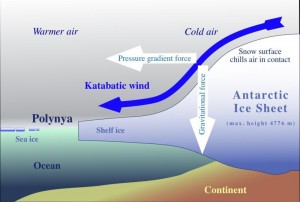
Image courtesy of Hannes Grobe, Alfred Wegner Institute for Polar and Marine Research (Wikimedia).
Katabatic winds in Antarctica and Greenland are intensely cold and fast, frequently reaching hurricane speed. Y'all can hear these fierce winds in this YouTube video
The winds in Antarctica comport small grains of sand that scour and erode the exposed rocks, resulting in unusual shapes and formations. These oddly shaped, eroded rocks are chosen ventrifacts.

Ventrifacts are wind-eroded rocks establish in the McMurdo Dry Valleys. They range from finger-sized to larger than houses. Photo courtesy of Kristan Hutchison, National Scientific discipline Foundation.
PLATE TECTONICS
The theory of plate tectonics describes the motions of earth's lithosphere, or outermost layer of difficult, solid rock, over geologic time. Plate tectonics provides scientists with a slap-up bargain of data about the polar region's past.

Tectonic plates. Paradigm courtesy of Wikimedia.
Earth's lithosphere is broken into seven major and many minor tectonic plates. These plates move in relation to each other, slowly changing the location of earth'due south continents and oceans.
Geological bear witness from Antarctica supports the theory that Due north America and Antarctica were connected approximately i billion years ago in the global supercontinent Rodinia. The continents eventually broke apart, merging again approximately 200 meg years ago in the supercontinent Pangaea. Fossil bear witness from this time period confirms that Antarctica was continued to Australia and Due south America and much warmer than it is today.
The movement of the tectonic plates also means that they are associated with much of the earth'south volcanic and seismic activity.
VOLCANOES
A volcano is but an expanse where magma, or molten rock, from the earth's mantle reaches the earth'due south surface, becoming lava. Most volcanoes occur at plate boundaries, where two plates are moving away (diverging) or together (converging). A few volcanoes like the Hawaiian Islands form from a hot spot, or a weak spot in earth's chaff, where magma forces its way to the surface.
Volcanic eruptions may be explosive (violent) or effusive (passive), depending on the lava chemistry (amounts of silica and dissolved gases). Silica is a mineral found in nature as sand or quartz. High levels of silica mean very viscous (thick) lava, and low levels mean more fluid lava. Dissolved gases build up inside the volcano, much similar a tin can of soda or other carbonated beverage. The college the level of gas, the more pressure that builds – and the more vehement an explosion. The combination of silica and dissolved gas levels determines the type of eruption and shape of the volcano.
Volcanoes are classified into iv types, based on their lava chemistry and shape.
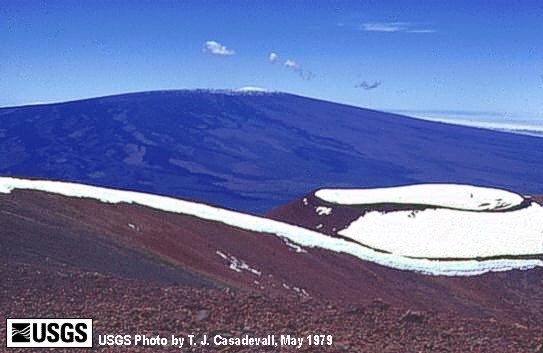 | Shield Volcano: A shield volcano has low levels of dissolved gas and silica in its magma. Its eruptions are effusive, and the very fluid lava moves rapidly away from the vent, forming a gently sloping volcano. Mauna Loa in Hawaii is an instance. |
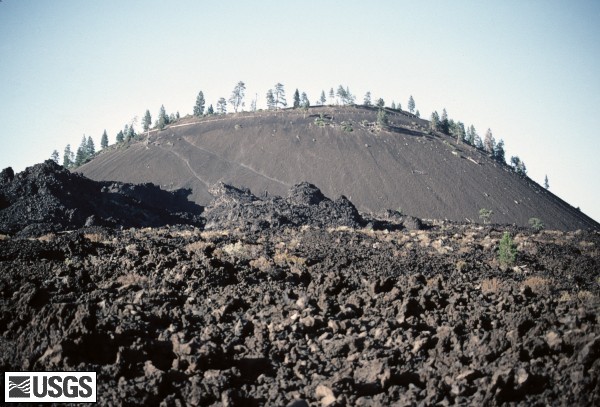 | Cinder Cone Volcano: A cinder cone volcano has low silica levels and loftier levels of dissolved gas, resulting in fluid lava that erupts explosively as a result of the immense force per unit area built in the magma chamber. A cinder cone volcano erupts by shooting fountains of fiery lava loftier in the air, which cools and forms a steep-sided conical structure. Lava Butte in Oregon is an example. |
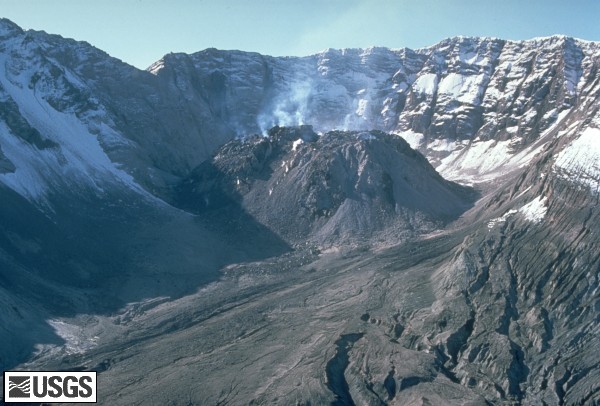 | Lava Dome Volcano: A lava dome volcano has high silica levels and low dissolved gases in its magma. This results in effusive, glutinous lava that forms a rounded, steep-sided mound. Lava domes are often created after an explosive eruption, which released much of the dissolved gas in the magma. The lava slowly continues to catamenia out of the volcano, forming a rounded, steep-sided mound. Since the 1981 eruption of Mt. St. Helens, a lava dome has been forming inside the crater of the volcano. |
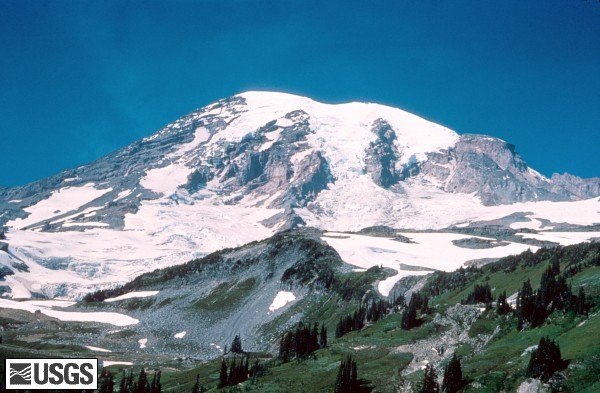 | Composite Volcano: A composite volcano has loftier levels of dissolved gas and silica and erupts explosively. Blended volcanoes often resemble steep-sided mountains before erupting. During tearing eruptions, information technology can seem every bit if the whole top of the mountain has been blown off. Eruptions often include pyroclastic material (ash and lava fragments), leaving the volcano to collapse inward and form a crater. Mt. St. Helens and Mt. Rainier in Washington are examples. |
Images courtesy of the U.S. Geological Survey.
Largely unexplored, the Gakkel Ridge runs underneath the Arctic Ocean. Scientists have discovered volcanic craters and show of surprisingly violent eruptions in the recent past.
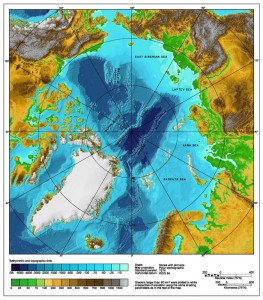
Map courtesy of the National Oceanic and Atmospheric Administration.
Antarctica, too, is dwelling house to volcanic activity. Ross Island, located in the Ross Ocean, is equanimous of three extinct volcanoes (Mt. Bird, Mt. Terror, and Hut Point) and Mt. Erebus, Antarctica's almost active volcano.

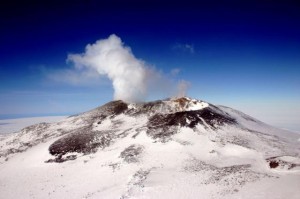
The summit of Mt. Erebus from the front end seat of a helicopter. Photo courtesy of Mt. Erebus Volcano Observatory.
Mt. Erebus is abode to a permanent lava lake, or a large amount of molten lava independent in a crater. Simply three volcanoes in the world have permanent lava lakes, making Mt. Erebus an of import research site for scientists looking to better understand the internal plumbing organisation of volcanoes. Even so, its location permits only a half dozen-week field flavour and its loftier distance (3794 meters) is physically challenging.
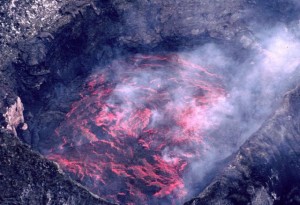
Mt. Erebus lava lake in 1983. Photo courtesy of Mt. Erebus Volcano Observatory.
Mt. Erebus is too notable for its persistent low-level eruptive activity (with almost daily eruptions). While the volcano has had some history of violent activity, most eruptions are passive lava flows similar to the volcanoes of Hawaii.
EARTHQUAKES
Seismic activity (earthquakes) is nigh oft associated with tectonic plate boundaries. As plates slowly move, their jagged edges stick and suddenly skid, causing an convulsion.
The Gakkel Ridge underneath the Chill Ocean experiences small earthquakes that accompany the volcanic activity found in the area. Antarctica, which lies in the eye of a tectonic plate, does not experience many earthquakes. Yet, seismic activeness is associated with eruptions of Mt. Erebus.
RELATED RESOURCES
Utilize these resources to larn more about erosion, volcanoes, earthquakes, and plate tectonics and how these agents of change affect the polar regions.
All About Glaciers
Learn how glaciers course, motion, and shape the mural.
Katabatic Winds
Basic data near the winds of Antarctica.
National Geographic: Forces of Nature
Explore volcanoes and earthquakes in this spider web site. Don't miss the interactive activities that allow yous to virtually erupt volcanoes and trigger earthquakes!
Polar Discovery: Arctic Seafloor Trek
During summer 2007, a team of scientists used autonomous underwater vehicles to explore the Gakkel Ridge. The Polar Discovery spider web site documents the expedition and provides background data, images, and video.
Mt. Erebus Volcano Observatory
Provides general information near Mt. Erebus, ongoing research, video, and a photo gallery.
National Scientific discipline Educational activity Standards: Science Content Standards
The entire National Science Education Standards document tin be read online or downloaded for free from the National Academies Press web site. The post-obit excerpt was taken from Chapter half-dozen.
A study of changes in the Earth's surface aligns with the World and Space Science, and the Scientific discipline in Personal and Social Perspectives content standards of the National Science Education Standards:
K-4 Earth and Space Scientific discipline: Changes in the Earth and Sky
- The surface of the globe changes. Some changes are due to wearisome processes, such as erosion and weathering, and some changes are due to rapid processes, such as landslides, volcanic eruptions, and earthquakes.
five-8 Earth and Space Science: Structure of the Earth System
- The solid earth is layered with a lithosphere; hot, convecting mantle; and dense, metallic cadre.
- Lithospheric plates on the scales of continents and oceans constantly move at rates of centimeters per twelvemonth in response to movements in the mantle. Major geological events, such as earthquakes, volcanic eruptions, and mountain building, result from these plate motions.
- State forms are the issue of a combination of effective and destructive forces. Constructive forces include crustal deformation, volcanic eruption, and deposition of sediment, while destructive forces include weathering and erosion.
five-8 Globe and Space Science: Earth'south History
- The world processes we see today, including erosion, movement of lithospheric plates, and changes in atmospheric composition, are like to those that occurred in the past.
- Fossils provide of import testify of how life and environmental atmospheric condition have inverse.
K-4 Science in Personal and Social Perspectives: Changes in Environments
- Changes in environments can be natural or influenced by humans. Some changes are good, some are bad, and some are neither good nor bad.
- Some environmental changes occur slowly, and others occur rapidly.
5-eight Science in Personal and Social Perspectives: Natural Hazards
- Internal and external processes of the earth organisation cause natural hazards, events that change or destroy human and wildlife habitats, damage holding, and harm or kill humans.
This article was written past Jessica Fries-Gaither. For more information, see the Contributors page. Email Kimberly Lightle, Primary Investigator, with whatever questions near the content of this site.
Copyright December 2008 – The Ohio State University. This cloth is based upon piece of work supported past the National Science Foundation nether Grant No. 0733024. Any opinions, findings, and conclusions or recommendations expressed in this material are those of the author(southward) and do not necessarily reverberate the views of the National Scientific discipline Foundation. This work is licensed nether an Attribution-ShareAlike 3.0 Unported Artistic Commons license
Source: https://beyondpenguins.ehe.osu.edu/issue/earths-changing-surface/the-forces-that-change-the-face-of-earth
Posted by: joneswittere.blogspot.com

0 Response to "How Earthquakes Change The Earth's Surface And Atmosphere"
Post a Comment